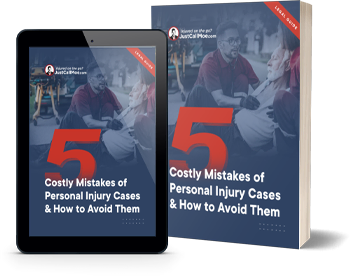A T-bone car accident is one in which one car is struck in the side by another vehicle, creating a T configuration of the two cars. They are also sometimes called broadside or side-impact collisions.
Common Causes
T-bone accidents usually happen when one driver makes a bad left turn or runs a red light or stop sign – often to make a left turn.
Examples of distracted driving includes:
- Texting
- Reviewing directions on phone or GPS
- Eating and drinking
- Adjusting music on the radio or other system
- Failure to yield right of way
- Operating with bad brakes
- Driving under the influence
Avoiding a T-Bone
There are several ways to avoid being in – or causing – a T-bone accident.
- Obey traffic signals and signs
- Slow down for yellow or flashing lights
- Practice defensive driving techniques
Common T-Bone Injuries
Injuries are likely to occur and are even more likely to be serious in a T-bone accident. Everyone is at risk on either side of the car.
The most common injuries in a T-Bone accident include:
- Head injuries
- Back and spinal injuries
- Neck injuries
- Torso injuries including pelvis, abdomen, and chest
- Injuries from flying debris
- Severe brain injury
Who Is Usually at Fault in a T-Bone
The at-fault driver is usually pretty easy to determine in a T-bone accident. Drivers hardly ever purposefully drive in front of an oncoming vehicle. Since T-bone accidents so commonly involve a driver making a left turn, that driver is usually easy to identify as the one at fault. Of course, it may be the case that a driver heading straight disregarded a traffic signal or sign and is the one at fault, at least to some extent. A speeding or distracted driver is also likely to be found at fault in the accident.
Contact A Florida Car Accident Attorney Today
Florida law requires that auto accident claims be filed within four years of the accident. That means you will not want to delay contacting the experienced Florida car accident attorneys at JustCallMoe who can give you a free case evaluation and help you to recover any damages you are entitled to. T-bone accidents can cause severe and life-changing injuries for which you need knowledgeable assistance.
FAQs
1. Where is a T-bone accident most likely to occur?
Since so many T-bones involve one driver who is turning left, they most often occur at intersections.
2. If I am partially at fault, can I still recover compensation after a T-bone accident?
Yes. In Florida’s pure comparative negligence rule, you can always recover up to the amount for which you are not deemed negligent. In other words, even at 99% fault, you can still recover 1% of your damages.
3. Can I recover for pain and suffering in Florida?
Pain and suffering damages are available in a Florida car accident and are not capped unless the case involves medical malpractice.

 (866) 225-5663
(866) 225-5663



